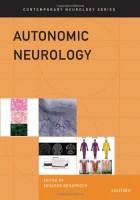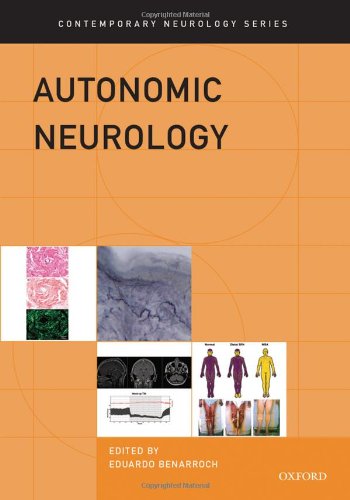 Editor: Eduardo E. Benarroch
Editor: Eduardo E. Benarroch
Publisher: Oxford University Press – 295 pages
Book Review by: Nano Khilnani
The autonomic nervous system (ANS or visceral nervous system) is that part of the peripheral nervous system that acts as a control system functioning largely below the level of consciousness, and controls visceral functions.
The ANS affects such bodily functions as the heart rate, digestion, respiration rate, salivation, perspiration, diameter of the pupils, urination, and sexual arousal. Whereas most of its actions are involuntary, some, such as breathing, work in tandem with the conscious mind. It is classically divided into two subsystems: the parasympathetic nervous system and sympathetic nervous system.
The parasympathetic nervous system is a division of the autonomic nervous system. The actions of the parasympathetic nervous system can be summarized as “rest and digest”. They include body functions like digestion and urination.
The sympathetic nervous system is another part of the autonomic nervous system. The action of the SNS regulates the “housekeeping” processes, such as tightening blood vessels when you stand up and increasing heart rate and force of the heartbeat when you exercise. It is sometimes referred to as the “flight or fight” system.
There are several common disorders of the autonomic nervous system, referred to generally as autonomic disorders. Among the common ones are: autoimmune autonomic ganglionopathy (AAG), Baroreflex failure, dopamine beta hydroxylase deficiency (DBH), hypovolemic postural tachycardia syndrome (POTS), multiple system atrophy (MSA) and pure autonomic failure (PAF)
The causes of these disorders are many, but for some such as PAF, the exact causes are not completely known. Some symptoms of PAF (most common in men) are: impotence, drop in blood pressure while standing (orthostatic hypotension) that can cause dizziness, fainting, and lack of steadiness, pain in the neck, loss of ability to sweat, the need to urinate at night (nocturia)
The focus of this book is on the pathophysiology, diagnosis, and management of the most common autonomic disorders that the clinical neurologist may encounter in the course of his practice. On the other hand there are other books on all aspects of autonomic anatomy, physiology, pharmacology and clinical evaluation and management of autonomic disorders.
Features that set this book apart from other recent books on the autonomic nervous system:
- Focus on clinical scenarios and presentation of clinical cases
- Figures showing the results of normal and abnormal autonomic testing in typical conditions
- Abundance of tables summarizing the differential diagnosis, testing, and management of autonomic disorders
The material in this book is divided into three Parts. For your easy overview of what you can find in this book, we provide you the coverage of those Parts as well as the titles of the chapters under each one. If you are looking for information on topics not covered in these chapters or in the Index, you can browse through the list of References at the end of each chapter.
- Basic Principles of the Functional Organization, Pharmacology, and Evaluation of the Autonomic Nervous System
- Central Autonomic Network
- Anatomy and Function of the Peripheral Autonomic System
- Autonomic Neurotransmission
- Autonomic Pharmacology
- Evaluation of Autonomic Disorders
- Pathophysiology and Management of Autonomic Disorders
- Neurogenic Orthostatic Hypotension
- Postural Tachycardia Syndrome
- Baroreflex Failure
- Syncope and Other Causes of Transient Loss of Consciousness
- Disorders if Sweating
- Neurogenic Bladder and Sexual Dysfunction
- Gastrointestinal Dysmotility
- Autonomic Hyperactivity
- Common Neurologic Autonomic Disorders
- Neurodegenerative Autonomic Disorders
- Autonomic Neuropathies
- Neuropathic Pain Disorders With Autonomic Content
- Autoimmune Autonomic Disorders
- Focal Disorders of the Cerebral Hemispheres and Brainstem
- Focal Disorders of the Spinal Cord
- Chronic Pain Disorders With Autonomic Features
The author has been able to explain complex neurological processes in a clear fashion. This book is a must for any neurologist in practice or research.
Editor:
Eduardo E. Benarroch is a Professor of Neurology and the Mayo Clinic College of Medicine. He is a clinical neurologist and neuroscientist with 25 years of experience as a consultant in the Department of Neurology at Mayo Clinic in Rochester, Minnesota.
He has extensive expertise in clinical and laboratory evaluation of patients with autonomic failure, including those with multiple system atrophy (MSA). As a neuroscientist, his area of expertise is the neuro-chemical anatomy of the brainstem and hypothalamus in humans. Over the past 15 years, Dr. Benarroch has published 190 peer-reviewed articles and four books.
Contributing Authors:
Jeffrey W. Britton
Michelle L. Mauermann
Brian Moseley
Wolfgang Singer
Jennifer A. Tracy







